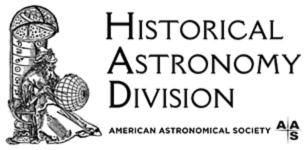This Month in Astronomical History: The Discovery of Ceres
Teresa Wilson United States Naval Observatory
 Each month as part of this series from the Historical Astronomy Division of the AAS, an important discovery or memorable event in the history of astronomy will be highlighted. This month, we look at the discovery of Ceres.
Each month as part of this series from the Historical Astronomy Division of the AAS, an important discovery or memorable event in the history of astronomy will be highlighted. This month, we look at the discovery of Ceres.

Which is better? To discover a new object in a known category or to discover an entirely new category of objects? This question is at the heart of the ongoing Pluto controversy, but Pluto is far from alone when it comes to being reclassified. Ceres, the largest object in the asteroid belt, has been through this dilemma twice since its discovery; it was demoted from “planet” long before Pluto was even a gleam in any astronomer’s telescope.
The large, seemingly empty space between the orbits of Mars and Jupiter drew astronomers’ attention dating back to the 1500’s and the days of Johannes Kepler and Tycho Brahe. The pattern of these and other planets’ orbits led Kepler to believe that some undiscovered planet must reside there. Fast-forward to the 18th century, the Prussian astronomer Johann Titius theorized a relationship between a planet’s distance from the Sun and its sequence in position. His theory essentially states that, in outward sequence, each planet is twice as far from the Sun as the previous one. This law became known as the Titius-Bode law after being popularized by the German astronomer Johann Bode. Aside from the missing planet between Mars and Jupiter, it described the positions of the then known planets well, including that of Uranus after its discovery in 1781. A group of astronomers popularly known as the “Celestial Police” turned their telescopes to the yawning gap to find this elusive world.
On 1 January 1801, with his invitation to join the Celestial Police still in the mail, Giuseppe Piazzi, an Italian priest, mathematician, and astronomer, was looking for a well-known star when he discovered another star-like object moving across the field of his target. Initially thinking it a comet, Piazzi observed it 24 times over the next month and determined from its motion that it might be a planet. In April, he sent his complete observations to Paris and they were published in September. However, due to the object’s position in relation to the Sun, his observations were not verified until December. It was named Ceres, after the Roman goddess of grain. Astronomy textbooks listed it as a planet for the next 50 years.
From 1800 to 1806, other similar objects were discovered in Ceres’ neighborhood. Astronomers began to wonder if they had, in fact, stumbled across a whole new category of objects. In 1802, William Herschel chose the term “asteroid”, coined by the Greek scholar Charles Burney Jr., to describe them. By the 1860’s, with the realization that Ceres had several hundred similar neighbors, the distinction between planets and asteroids was widely accepted, although what constitutes a planet was still unclear.
In 2006, Pluto’s planetary status was under scrutiny, and the IAU more precisely defined a planet’s bona fides. Because Pluto did not make the cut, it became the first of the new category, dwarf-planets. Ceres was the second object relegated to dwarf-planet status and remains the only dwarf-planet in the asteroid belt. In March 2015, the Dawn spacecraft arrived at Ceres to make NASA’s first visit to a dwarf-planet.
Ultimately, the manner of an object’s classification is linked to scientific advancement and our understanding of the universe. As we have learned more about the objects in our solar system and beyond, astronomers have re-classified Ceres twice, each time being one of the first of a wholly new category.
Photo: Approximate true-color image of Ceres. [NASA/ JPL-Caltech / UCLA / MPS / DLR / IDA / Justin Cowart]
- Hilton, J. L. 1999 "U.S. Naval Observatory Ephemerides of the Largest Asteroids". The Astronomical Journal. 117 (2): 1077–1086.
- IAU 2006 “Resolution B5: Definition of a Planet in the Solar System”
- Landau, E., & Dyches, P 2015. "Fly Over Ceres in New Video". NASA. Retrieved 9 June 2015.
- Herschel, William 1802. "Observations on the two lately discovered celestial Bodies". Philosophical Transactions of the Royal Society of London. 92: 213–232
- Cunningham, C. J. 2016. “Discovery of The First Asteroid, Ceres”. 1st ed. Springer.
- "Pluto and the Developing Landscape of our Solar System". 2017. iau.org. https://www.iau.org/public/themes/pluto/
Each month is an exciting new adventure into the archives of astronomical history, but before I continue any further, I would appreciate your feedback to ensure my writing is reaching the largest audience possible. Please participate in a brief questionnaire (approximately 10 minutes) about the style and content. You may also submit any suggestions for future topics. Thank you!

